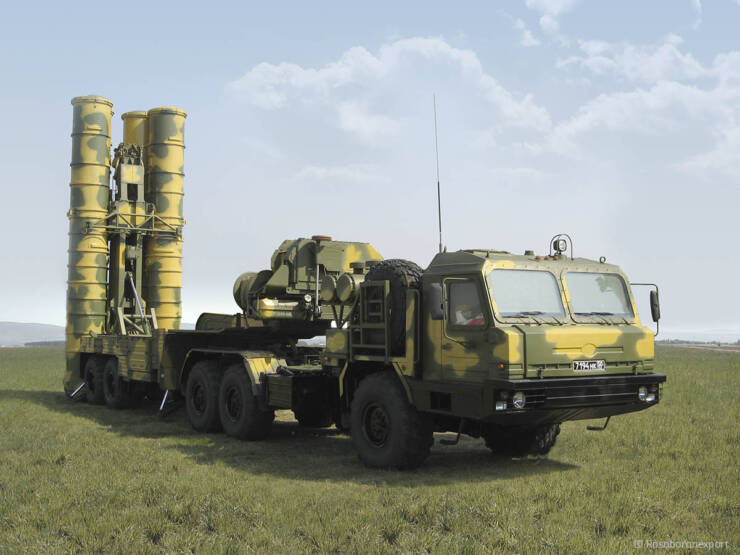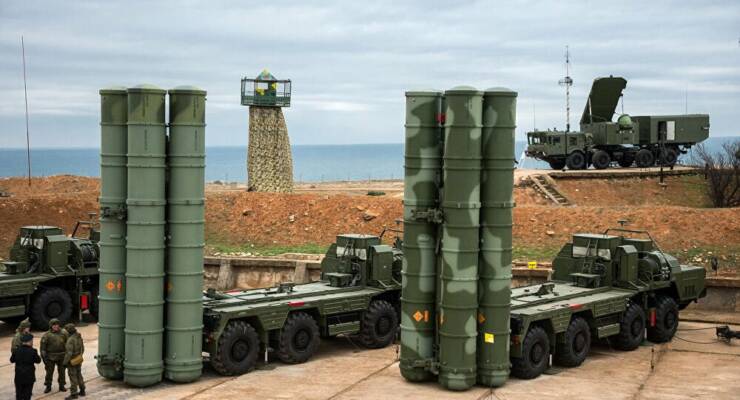
The year is 2022. A posse of F-16 jet fighters takes off from the main Pakistan Air Force (PAF) base in Sargodha. Approximately 300 km east, at the Indian Air Force (IAF) base in Adampur, Punjab, an S-400 Triumf air defence system picks up these aircraft almost instantly. The radar lock unnerves the F-16 pilots and they peel further west – away from the battery’s radar range.
The F-16s fly towards Balochistan – the furthest they can get away from the Indian border. But here they are tracked by another S-400 battery stationed near the Jodhpur air force base 527 km away.
This isn’t war – the S-400 systems are just routinely scanning the airspace around them in a 360 degree sweep. But the PAF pilots are on the verge of panic. Between the overlapping coverage by India’s multiple S-400 battalions stationed along the border, PAF aircraft can run but not hide. This is the fishbowl effect – the feeling of being observed from all sides.
Russia has started delivering the powerful S-400 Triumf air defence system to India. Dmitry Shugayev, the head of the Russian military cooperation agency, said the first of five units will arrive in the country by the end of the year. Considered one of the most advanced weapons in the world, it is a rare example of an air defence system with an offensive, first-strike capability.
Each S-400 missile defence unit has two batteries, each of which has a command-and-control system, a surveillance radar, an engagement radar and four launch trucks. The system is equipped with four different missiles, which can engage enemy aircraft, ballistic missiles and cruise missiles. The exact type and range of missiles that India has purchased remains classified.
The most devastating impact of India acquiring the S-400 will be on the Pakistani military’s psyche. With its 600 km tracking range – and a 400 km kill range – the air defence system will increase the vulnerability of all Pakistani air assets, especially fighter aircraft, missiles and drones, by several orders of magnitude. According to an article in US Air Force’s ‘Journal for Indo-Pacific Command’, the S-400 has “surfaced as an anti-access/area denial (A2/AD) asset designed to protect military, political, and economic assets from aerial attacks”.
Due to their vast range, just three S-400 battalions located on the border will cover all of Pakistan, except the western extremity of its restive Balochistan province. The arrival of the S-400 will squeeze the operational capabilities of the PAF’s offensive as well as defensive assets.
Because of its blistering speed of 17,000 kph, an S-400 missile fired from Adampur will take just 65 seconds to hit an F-16 flying over Sargodha. Ejection – rather than evasive action – would be the sensible option against a missile coming at you at that speed. (This is assuming the IAF has opted for the fastest missile type and that Russia has decided to sell it.)
The S-400’s deployment will widen the window of vulnerability of Pakistan’s air force, army and strategic missile forces in a variety of ways:
*First up, PAF jets will be forced to operate hundreds of kilometres west of the Indian border and will have to fly in a narrow strip of airspace along the borders of Iran and Afghanistan.
*Secondly, they will not be able to come to the defence of their armour and troop concentrations which would be taking a pounding from Indian artillery and the IAF.
*The system can even function as a ballistic missile killer until India’s indigenous ballistic missile defence system comes online in the years ahead.
Manufactured by Russia’s Almaz Antey and introduced into service in 2007, the S-400 system consists of a set of radars, missile launchers and command posts. Depending on the export version, each S-400 system is capable of tracking between 100 and 300 targets. It can engage up to 36 targets simultaneously within a range of 400 km, ensuring that all Pakistani air bases come under its range. Chinese air assets in Tibet will also come within striking distance. The S-400’s offensive-defence capability means IAF aircraft won’t have to undertake overly risky strike missions into enemy airspace until it is sanitised.
Why India needs battlefield defence systems
Air defence is a critical aspect of war. If the enemy is able to penetrate your airspace, his first targets are high value military and industrial establishments like airfields, cantonments and power plants, as well as transport networks.
Because of India’s vast landmass the IAF cannot be at all places at all times. The long range of the S-400’s powerful AESA (active electronically scanned array) radar fills these gaps. The S-400 missile system can even take out aircraft with low-observable technology. “For the S-400 there is no such thing as ‘stealth’ aircraft; the system will see it and will shoot it down,” an S-400 battery commander was quoted as saying in the Russian media.

The S-400 can “see” everything both in the air and on the ground, and can easily discern even a tiny aircraft from, say, a truck moving on the ground, the commander added. “Even if a plane is flying low and with the same speed as a vehicle moving on the ground, the radar will show it on the screen.”
Integrated missile defence
While the S-400 is clearly one of the most capable and lethal long-range air defence missile systems on the planet, air defence works best when all its components operate in sync. The Triumf becomes deadlier if it is used alongside short and medium range missiles, anti-aircraft artillery (AAA) and fighter aircraft. By dominating high altitude air space (up to 185 km), the S-400 can drive enemy aircraft down into a “flak trap” where AAA batteries and air defence fighters await them. If India can successfully integrate this multi-tier system, it can significantly increase the costs for attacking air forces.
Counter measures
Of the five systems ordered, India could deploy three on the Pakistan border and two along the Himalayas to counter China. However, it is Pakistan that will suffer the most as its entire territory will be swept by the S-400’s claimed jamming-resistant radar. Since the PAF’s offensive and defensive assets are thin, Pakistan could try and overwhelm Indian air defence systems by launching a large number of missiles of which it has plenty. However, this could be suicidal as it will invite a massive retaliation from India’s strategic command.
The entry of the S-400 will force Pakistan to spend heavily on more numbers of aircraft and missiles – including prohibitively expensive hypersonic ones – needed to neutralise the huge Indian advantage. Given the Pakistani military’s obsessive desire to achieve parity with India, it may go for the HQ-15 – a Chinese knockoff of the older Russian S-300 system. In October 2021, Pakistan commissioned the HQ-9 with an engagement range of 100 km.
With the Pakistani economy not exactly in the pink of health, the additional spending will come at the expense of economic growth needed to employ, feed and house its growing population. Disenchantment with the government’s policies will set in motion the same set of forces that led to the country’s breakup in 1971 and the creation of Bangladesh.
India’s next move
The S-400 may seem like a stopgap arrangement until India’s indigenous ballistic missile defence system attains maturity. Considering the history of defence production in the country, delays are inevitable. India should, therefore, explore the possibility of producing the S-400 locally and also take first dibs on the futuristic S-500 Prometheus – yet another frightening air defence weapon from Russia. Constantly ramping up military pressure on Pakistan is the surest way to engineer the collapse of its dilapidated economy.
–The writer is a globally cited defence analyst. His work has been published by leading think tanks, and quoted extensively in books on diplomacy, counter terrorism, warfare and economic development. The views expressed are personal and do not necessarily reflect the views of Raksha Anirveda








